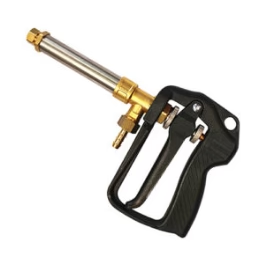Getting Into Farming? Get an Understanding of Sprayer Parts and Accessories
Farming or gardening has many aspects you must practically go through to understand how they work. But agricultural spraying is one of the crucial practices you must do right to maximize your yields. Sprayers play a vital role in efficiently applying fertilizers, pesticides, herbicides, and other agricultural chemicals to crops.
Hence, understanding the key spray equipment parts and accessories is crucial for optimal performance and troubleshooting by ensuring effective application. So let's explore the basic parts that make up most sprayers, like nozzles, strainers, prime mover, tank, air chamber, pressure gauge, etc. But before that, you should know the different types of agri sprayers you can use in farming to understand their key parts.
What are the various types of sprayers?
Sprayers are one essential tool every professional agricultural and gardener should have in their inventory for optimal growth of their plants. The sprayers come in different types, each designed to meet specific needs and applications, so the sprayer parts may have different specifications. Let's explore the various types of sprayers and their uses:
Portable power sprayer
Using a portable power sprayer can be highly efficient if you have large-scale agricultural applications. An internal combustion engine or an electric motor typically powers these sprayers. Due to their high-pressure generation, the sprayer can cover large areas quickly. Portable power sprayers are commonly used for spraying fertilizers, herbicides, insecticides, and other agricultural chemicals on crops, orchards, and fields.
Knapsack sprayer
The most common and convenient sprayer is a knapsack sprayer or backpack sprayer. It is manually operated and is designed to be carried on the operator's back. They are versatile and widely used for small to medium-sized farming tasks. Knapsack sprayers are best suited for spraying fertilizer or herbicide solutions on crops, gardens, and orchards. Knapsack sprayers have an ergonomic design and adjustable nozzles, which make them convenient for precise and targeted spraying.
Compression or tank sprayer
Another widely used sprayer for farmers and gardeners is the compression or tank sprayer. The spray equipment parts consist of a tank, a pump, and a nozzle. The tank is filled with the desired liquid, and the pump pressurizes it. When the trigger is squeezed, the liquid is sprayed through the nozzle.
Compression sprayers are most suitable for gardening purposes for pest control, applying household chemicals, and spot treatments. They come in various sizes, ranging from handheld units for small-scale applications to larger units with shoulder straps if you have extended-use requirements.
Hose-end sprayer
Hose-end sprayers are convenient and easy-to-use sprayers attached to a garden hose. These sprayers mix the liquid concentrate with water as it flows through the device. They typically have adjustable dials or settings to control the dilution ratio. These sprayers are best for large areas like landscapes, gardens, lawns, etc., for watering plants with nutrient solutions, fertilizers, and applying insecticides or herbicides.
Mist dust sprayer
Using a mist dust sprayer can benefit you most if you have orchards, vineyards, and agricultural fields. They are designed to disperse fine mist or dust particles for uniform coverage of plants and crops. Mist sprayers efficiently apply foliar fertilizers, insecticides, and fungicides to avoid orchard plants having arbitrary chemical pools on some parts and not cutting to the infested areas.
Various agricultural sprayer parts and accessories
It's crucial to know the sprayer parts & accessories that play a crucial role in the functionality and performance of agricultural sprayers. Here are the key components parts you should know about:
Nozzle
The nozzle is one of the critical sprayer parts that control the spray pattern, droplet size, and flow rate. Different types of nozzles are available to suit specific applications, such as flat fan nozzles for uniform coverage or adjustable nozzles for variable spray patterns.
Strainer
You can find the strainers typically at the inlet of the sprayer tank, which prevents debris or particles from clogging the system. The strainers ensure that the liquid flowing into the sprayers is clean and free from contaminants, which maintains the efficiency of the sprayer and protects the other components.
Tank
The sprayer tank is where the equipment holds the liquid solution or chemicals which will be sprayed. Depending on your specific requirements, it is available in various sizes and materials, such as polyethylene or stainless steel.
Air Chamber
The air chamber in the sprayer is also known as an air gap that prevents liquid from back flowing into the pump or contaminating the water source. It helps maintain a consistent pressure avoiding any damage to the pump.
Pressure Regulator
The pressure regulator controls and maintains the desired pressure within the sprayer system. It ensures a consistent spray pattern and droplet size, optimizing the effectiveness of the application.
Pressure Gauge
As the name suggests, the pressure gauge displays the pressure readings within the sprayer system, allowing operators to monitor and adjust the pressure as needed.
Prime mover
The prime mover refers to the power source that drives the sprayer. The mover can be of electric motor, gasoline engine, or tractor power take-off.
Sprayer parts and accessories are essential for maintaining agricultural sprayers' efficiency, reliability, and safety. Now that you know about the essential parts, it would be helpful to make a proper selection and installation for achieving accurate and effective spraying results.





Comments
Post a Comment